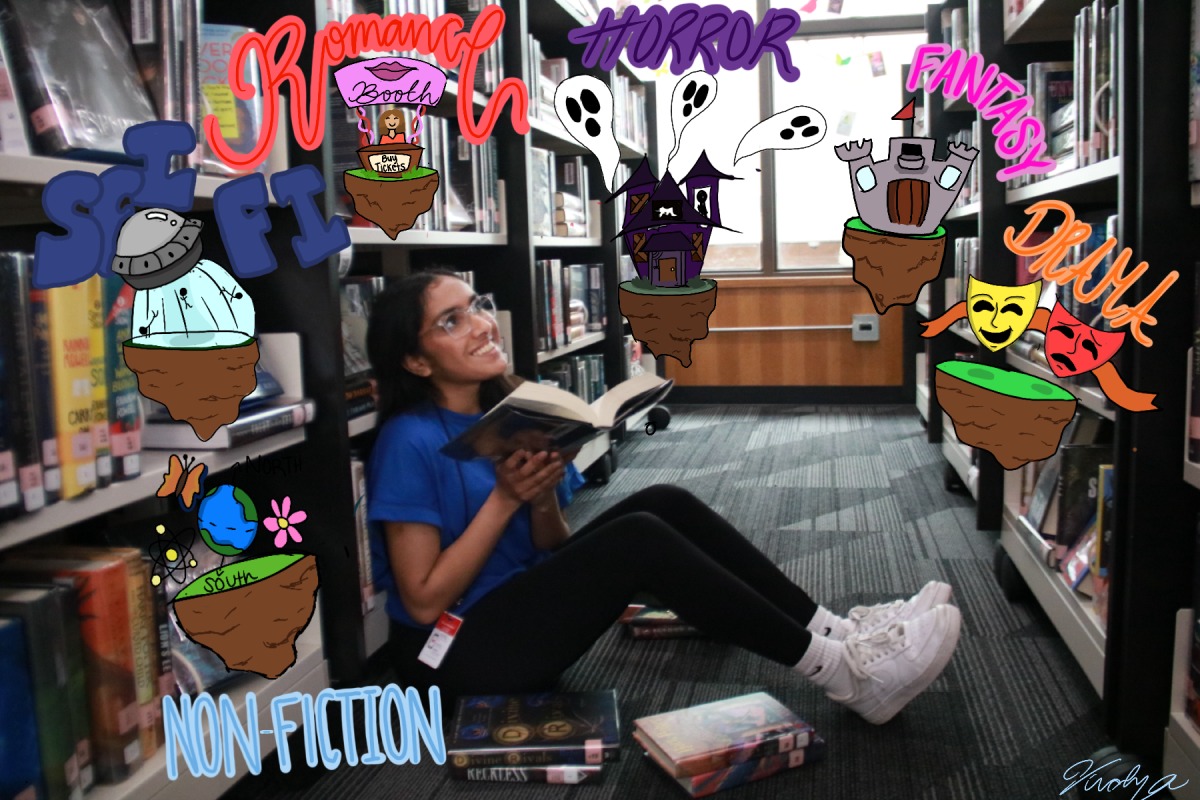
Aamna Mirza
Books have different genres specialized to anyone's liking and to make them enjoy reading more. The Sidekick staff writer Gia Ajani thinks reading books expands young students' minds and exposes them to different worlds beyond our own, building stronger leaders for the future. Photo Illustration by Vidya Praveen
Even with my busy schedule, consisting of rigorous classes, electives and activities, I make time to read. Whether through an audiobook or e-book, I find ways to continue to make myself interested and engaged in what I am reading.
To me, reading is not just an academic skill; it is a pathway to endless opportunities and stories, expanding young children’s and adults’ imaginations and perspectives.
Reading teaches students how to problem solve, think critically, digest information and build a deeper connection to the context of a situation. As a student, my knowledge of “big words” can be credited to the many books I have read.
As a young, avid reader it shocks me when people say they have not read a book since middle school or have only read books mandatory for English classes. This is the reality for many high schoolers, as academic reading has taken the enjoyment from personal reading.
With high school students’ busy schedules, students do not have time to read for their enjoyment but only read for necessary classes. Even for required readings, students are still using resources such as Sparknotes, artificial intelligence and other summarization tools for English classes.
Many assigned reading books, such as Romeo and Juliet or Fahrenheit 451, which many students are required to read for English classes, can feel outdated. These books have deeper literary understandings but fail to connect with students due to the language and themes, which can lead reading to be seen as a chore rather than for enjoyment.
According to the National Assesment of Education Progress, 39% of students in the eighth grade were reading below the proficient level, which is a record high in decades.
The increase in technology and short media content on apps, such as TikTok and Instagram, has shortened students’ attention spans and led to instant gratification, leaving the brain craving for quick information, which can cause students to lose focus on reading longer texts that require in-depth thinking. Teenagers are averaging almost five hours a day on platforms such as TikTok and Instagram, providing no benefit for the attachment to these types of content.
Ironically, book platforms such as BookTok have made reading more appealing to young adults through various social media trends and content created by a community for all readers. This has caused a shift in what young adults are reading, as they can see their favorite topics incorporated into digital reading.
In Coppell High School, English II Honors class students choose books to read for certain units. Being able to choose books such as Shatter Me and The Inheritance Games has not only made me more excited about what I was reading but also encouraged me to have a deeper understanding of what I was reading and connect it to my life.
One way we can bridge the gap between students and reading is by getting them interested in the topics they enjoy reading and letting them choose their own books. For example, a student who loves romantic comedy movies may enjoy reading Better Than The Movies or a popular movies series that originated from a book — To All the Boys I’ve Loved Before. Fantasy fans may enjoy The Lunar Chronicles series or Red Queen.
Through the power of stories we can inspire students to become lifelong learners and leaders who are capable of changing their own lives.
Reading should not feel like a chore; instead, it should be an escape to experience thousands of worlds beyond textbooks. By creating comforting spaces for students to read and explore different types of books, we can help educate and expand students’ knowledge.
One page at a time.
Follow @CHSCampusNews on X.